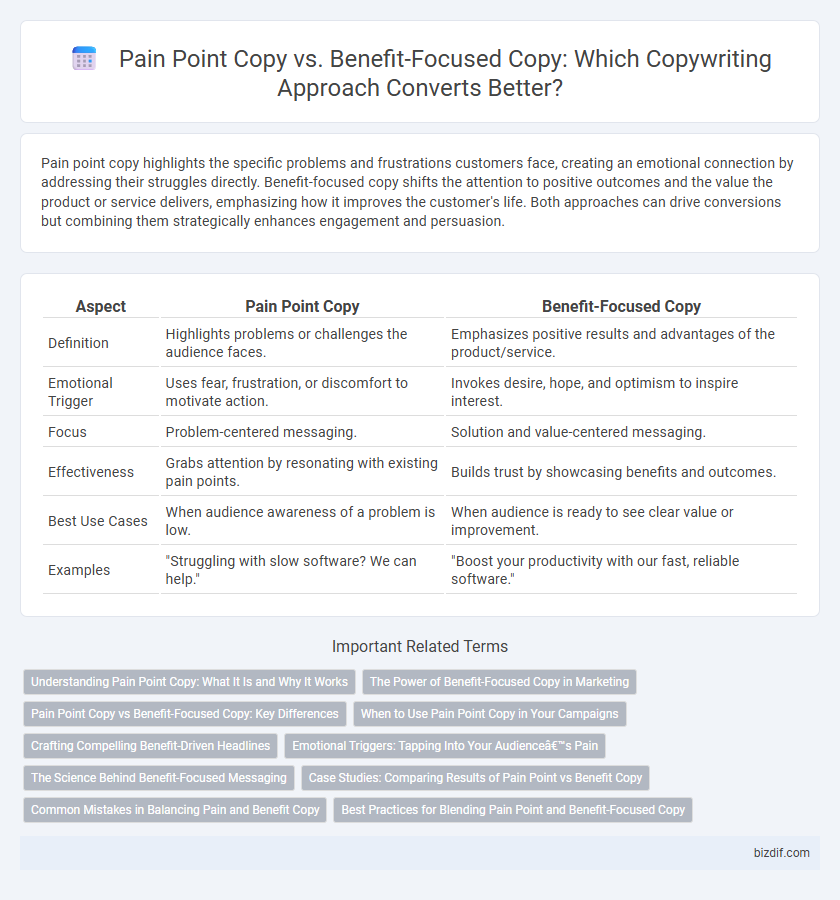Pain point copy highlights the specific problems and frustrations customers face, creating an emotional connection by addressing their struggles directly. Benefit-focused copy shifts the attention to positive outcomes and the value the product or service delivers, emphasizing how it improves the customer's life. Both approaches can drive conversions but combining them strategically enhances engagement and persuasion.
Table of Comparison
| Aspect | Pain Point Copy | Benefit-Focused Copy |
|---|---|---|
| Definition | Highlights problems or challenges the audience faces. | Emphasizes positive results and advantages of the product/service. |
| Emotional Trigger | Uses fear, frustration, or discomfort to motivate action. | Invokes desire, hope, and optimism to inspire interest. |
| Focus | Problem-centered messaging. | Solution and value-centered messaging. |
| Effectiveness | Grabs attention by resonating with existing pain points. | Builds trust by showcasing benefits and outcomes. |
| Best Use Cases | When audience awareness of a problem is low. | When audience is ready to see clear value or improvement. |
| Examples | "Struggling with slow software? We can help." | "Boost your productivity with our fast, reliable software." |
Understanding Pain Point Copy: What It Is and Why It Works
Pain point copy targets specific problems or challenges the audience faces, creating an emotional connection by highlighting their frustrations and obstacles. This approach resonates deeply because it validates the customer's experience and positions the product or service as the solution they urgently need. By addressing the pain directly, copywriters increase engagement and drive conversions through empathy and relevance.
The Power of Benefit-Focused Copy in Marketing
Benefit-focused copy drives higher engagement by clearly addressing the desired outcomes and advantages customers seek, making the product or service personally relevant. Highlighting specific benefits taps into consumer motivations, increasing the likelihood of conversion by showcasing real value instead of merely solving problems. Marketing strategies anchored in benefit-focused messaging consistently outperform pain point copy by fostering positive emotional connections and inspiring trust.
Pain Point Copy vs Benefit-Focused Copy: Key Differences
Pain Point Copy highlights the specific problems or challenges that the target audience faces, triggering emotional responses and urgency for a solution. Benefit-Focused Copy emphasizes the positive outcomes and value customers gain from a product or service, fostering desire and motivation. Understanding these key differences helps marketers tailor messages effectively to either address immediate pain or inspire potential success.
When to Use Pain Point Copy in Your Campaigns
Use pain point copy in campaigns targeting audiences experiencing clear challenges or frustrations, as it directly addresses their specific problems and evokes emotional responses that drive engagement. This approach works best in industries where customers actively seek solutions, such as healthcare, financial services, or technology. Highlighting pain points early in the buyer's journey increases relevance and urgency, motivating prospects to consider your product or service as the optimal remedy.
Crafting Compelling Benefit-Driven Headlines
Crafting compelling benefit-driven headlines boosts engagement by clearly communicating the positive outcomes customers will experience. Benefit-focused copy highlights specific advantages like time savings, cost efficiency, or enhanced user experience, capturing attention quickly. Effective headlines prioritize clarity and relevance, directly addressing customer needs to increase conversion rates.
Emotional Triggers: Tapping Into Your Audience’s Pain
Pain point copywriting leverages emotional triggers by highlighting specific problems and frustrations your audience experiences to create a sense of urgency and relatability. Focusing on the audience's pain taps into their fears, desires, and unmet needs, prompting a stronger emotional response that drives engagement and action. This approach often yields higher conversion rates by directly addressing the obstacles preventing potential customers from achieving their goals.
The Science Behind Benefit-Focused Messaging
Benefit-focused copy leverages cognitive psychology principles by appealing directly to consumers' desires and emotions, creating a positive mental association with the product. Neuroscientific studies reveal that highlighting benefits activates the brain's reward centers, enhancing motivation and recall more effectively than pain point copy. This approach increases engagement and conversion rates by aligning marketing messages with consumers' intrinsic goals and aspirations.
Case Studies: Comparing Results of Pain Point vs Benefit Copy
Case studies reveal that pain point copy often drives higher engagement by resonating with customers' immediate challenges, resulting in improved click-through rates and conversions. Benefit-focused copy excels in nurturing long-term interest by clearly communicating product advantages and emotional value, enhancing brand loyalty. Data from A/B testing indicates combining both strategies strategically can optimize overall campaign performance and maximize ROI.
Common Mistakes in Balancing Pain and Benefit Copy
Common mistakes in balancing pain point copy and benefit-focused copy include overemphasizing pain points, which can alienate readers and create a negative brand perception, or focusing too heavily on benefits without addressing the pain, leading to a lack of urgency and reduced conversion rates. Ignoring the emotional triggers behind pain points or failing to clearly demonstrate how benefits directly solve those pains diminishes the effectiveness of the message. Crafting copy that simultaneously acknowledges customer struggles and highlights compelling solutions ensures greater engagement and drives more impactful calls to action.
Best Practices for Blending Pain Point and Benefit-Focused Copy
Effective copywriting blends pain point and benefit-focused copy by first identifying the target audience's specific problems and then clearly presenting solutions that highlight tangible benefits. Using empathetic language to acknowledge struggles creates emotional connection, while demonstrating how the product or service alleviates pain reinforces value and motivates action. Balancing problem awareness with outcome-driven messaging increases engagement and drives higher conversion rates.
Pain Point Copy vs Benefit-Focused Copy Infographic

 bizdif.com
bizdif.com